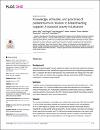Prevalence and predictors of breastfeeding practices in Saudi Arabia: a national cross-sectional study based on the 2021 WHO breastfeeding indicators.
| Author | Alhreashy, Fouzia Abdulaziz |
| Author | Alhammadi, Areej Ibrahim |
| Author | Aljabar, Badryah Abdullrhman |
| Author | Al Zahraa Chokor, Fatima |
| Author | Hakami, Mona Abdullah |
| Author | Albalawi, Monirah Amiad |
| Author | Alsomali, Nawal Taher |
| Author | Alsadah, Rana Majid |
| Author | Labban, Ranyah Shaker |
| Author | Al-Jedai, Ahmed Hamdan |
| Author | Nasreddine, Lara Mahmoud |
| Available date | 2025-06-12T06:42:37Z |
| Publication Date | 2025-06-05 |
| Publication Name | International Breastfeeding JournalBioMed Central |
| Identifier | http://dx.doi.org/10.1186/s13006-025-00729-1 |
| Citation | Alhreashy, F.A., Alhammadi, A.I., Aljabar, B.A. et al. Prevalence and predictors of breastfeeding practices in Saudi Arabia: a national cross-sectional study based on the 2021 WHO breastfeeding indicators. Int Breastfeed J 20, 47 (2025). https://doi.org/10.1186/s13006-025-00729-1 |
| Abstract | Breastfeeding is described as a cost-effective strategy to improve child survival, growth and development, and reduce the risk of non-communicable diseases later in life. This study aims to provide national estimates for the six breastfeeding indicators set by the World Health Organization and United Nations Children's Fund (WHO/UNICEF) in the Kingdom of Saudi Arabia (KSA) and identify factors associated with inadequate breastfeeding practices in the country. A national cross-sectional survey was conducted in KSA's five regions between May and December 2023. Birth registry data were used to randomly select the study sample (n = 9242) Infant and Young Children (IYC) below 24 months of age. Data was collected via phone-based interviews with mothers as main respondents. The 24-h recall approach was used to collect information about the current infant feeding practices. Results showed that the prevalence of early initiation of breastfeeding (EIBF) and exclusive breastfeeding for the first two days (EBF2D) were 43.4% and 31.3%, respectively. Exclusive breastfeeding (EBF) under six months and mixed milk feeding (MixMF) were reported by 15.5% and 34.9% of mothers, respectively. Only 5.8% of infants aged 5-5.9 months were exclusively breastfed. The prevalence of continued breastfeeding (CBF) in the total sample of mothers was 19.6% and that of ever breastfeeding (EvBF) was 89.3%. Based on multiple logistic regression analyses, lower odds of meeting the breastfeeding indicators were noted amongst IYC of Saudi nationality, first-borns, or those born prematurely or by Cesarean section. Maternal employment/student status was associated with higher odds of MixMF. This study provided national estimates for the breastfeeding indicators that may serve as a baseline for future surveys, and identified population groups that are at higher risk of inadequate breastfeeding practices. The findings should guide the development of culturally appropriate interventions aimed at protecting, promoting and supporting EIBF and EBF in the hospital, after discharge and during six months after birth, and to raise awareness around the importance of CBF. |
| Language | en |
| Publisher | BioMed Central |
| Subject | Breastfeeding indicators Determinants Early initiation of breastfeeding Exclusive breastfeeding Infants and young children Saudi Arabia |
| Type | Article |
| Issue Number | 1 |
| Volume Number | 20 |
| ESSN | 1746-4358 |
Files in this item
This item appears in the following Collection(s)
-
Public Health [514 items ]




